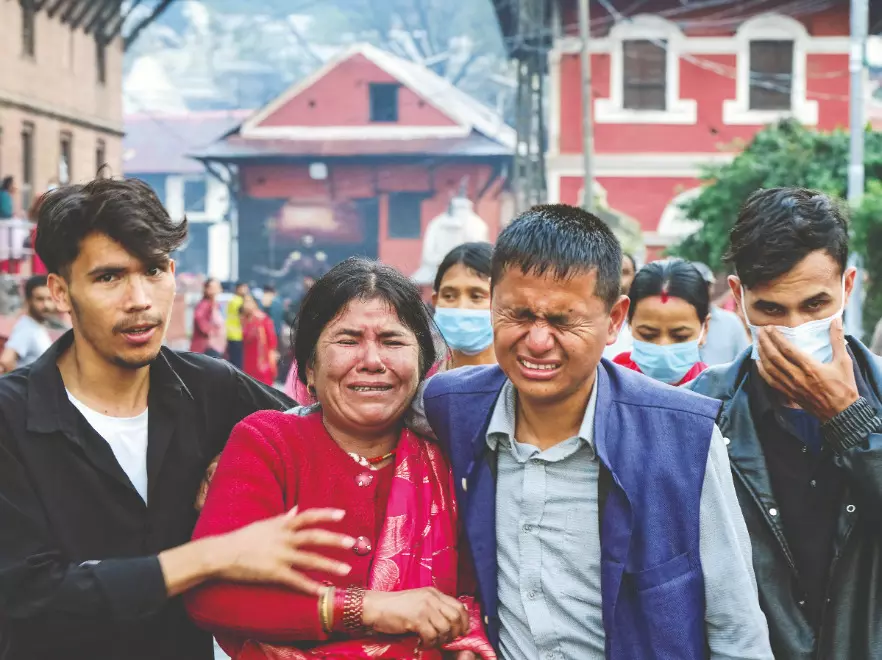Storm in the Himalayas
India’s neighbours have become victims of their own web of corruption, ethnic clashes and autocratic rule. For India, this is a time to refine regional diplomacy

“Tact is the ability to step on
a man’s toes without messing
up the shine on his shoes.”
— Harry S Truman
Strip the veneer of make-believe sovereignty and look closer at Nepal. You will soon realize that this nation has not had true democracy for years. This hammer-truth also holds good for Bangladesh, Sri Lanka and Pakistan. For every Indian, just being geographically surrounded by these four nations is cause for pride, if only because India is still among the fastest-growing economies globally. The fact that India has managed to pull this off while being multi-cultural, multi-caste and multi-religion makes the achievement all the more commendable.
The simple truth is that India’s neighbours have fallen prey to their own woes of corruption, ethnic clashes or autocratic rule. Look at the latest to topple a government, Nepal, which was run by a Rana and then by a monarch, both of whom lacked the teeth or grey matter to clench on to the hopes, dreams and aspirations of the people. Rana was unceremoniously thrown out, making way for a King who didn’t just make a hash of his kingdom and kingship, he made mincemeat of monarchy itself.
Today, even the dream of democracy in Nepal has taken a chai break. The Nepalese coup (the frequency could see it being compared to a ‘rearrangement of democratic furniture’) has once again plunged the Himalayan nation into a spiral of uncertainty. For a nation that has changed Prime Ministers more frequently than its cricket team changes captains, this latest overthrow comes not as a shock but as just another tumultuous chapter in its constipated identity crisis.
Jumping Without a Bungee
To be fair, Nepal has long been a political trapeze act without a safety net. From being the world’s only Hindu kingdom to a secular democratic republic (on paper), it has oscillated with the grace of a metronome, and with about as much emotion. What began as a monarchy was challenged by Maoist insurgence, reshaped by constitutional debates and periodically rebooted by elections. It has now dissolved into an ambivalent instability that people are used to, like traffic in Delhi or power cuts during an Indian summer. But while Nepal may be enduring yet another democratic experiment, it does prompt an urgent and wider question—should India be worried?
Before we answer that, let’s pan out for a bit. Nepal is not alone in its chaotic conduct and goings-on. Across the subcontinent, India has been blessed with neighbour nations that have, of late, taken turns to showcase their innate yearning for instability. Sri Lanka made global headlines with its economic collapse. Citizens stormed presidential residences and ended up queueing for fuel longer than Americans line up Mission Impossible tickets on Hollywood Boulevard. Bangladesh, once a poster child for development, is navigating concerns about authoritarian drift. Pakistan, being Pakistan, is always on such a political see-saw that even predicting the Prime Minister’s name in coming weeks is like a game of political football (it could even cause jailbreaks).
Together, these developments might make a lesser nation bite its nails. But India, relatively stoic and steady compared to its neighbours, is marching to a higher international economic presence. This juxtaposition—chaos outside and relative calm within—should make Indians appreciate and reflect on not just the stability they enjoy, but also the geopolitical tightrope that the nation is increasingly being forced to walk in today’s evolving Global Village.
Enter the Dragon…
That gets us to the China Equation, which is more of a chessboard than a playground. The shadow of China looms dark and vivid, especially because this is one neighbour not known for minding its own business. Nepal’s political shifts come with subtle (and sometimes not-subtle) pushes from Beijing, which has made inroads into the region with its ‘Belt and Road’ Initiative. Roads, dams, dry ports, housing complexes and whatnot. China is building much of the region’s infrastructure; in the process, it is cultivating future loyalties too.
With China in the mix, India is not playing a game of influence, but waging a battle for strategic survival. Every time a friendly regime is replaced in Kathmandu, Colombo or Dhaka, China sees an opening. And being the dragon that it is, China plays only to win. That alone is reason for India to sharpen its regional diplomacy multi-fold; not with the swagger of a big brother, but with the wisdom of a stakeholder. The era of passive observation is over. Unless India gives top priority to regional ties, it may soon find itself surrounded by unstable regimes, by governments whose idea of neighbourly love includes China-built highways that lead straight to Delhi’s tenderest spots.
Stability is Never Accidental
What are the lessons for India in this regional mulch? One, complacency is a luxury that India cannot afford. Its house may appear to be in order, but maintaining that order requires constant vigilance. Economic growth, cultural diversity and political stability do not simply exist; they need to be actively protected and nurtured.
Two, India needs to realize that regional leadership is not a trophy, but a responsibility. It cannot cite GDP or space missions as proof of superiority. Soft power, economic support and principled diplomacy must form the toolkit of foreign policy. This is not a time to preach, but to partner.
Three, India should pay attention to how its actions are perceived. The world has changed, as have regional dynamics. Paternalistic posturing, however well-intended, can backfire. Respectful engagement, grounded in mutual interests, is the only sustainable way forward.
India needs to address the elephant in the room too—US tariffs. Just when everyone thought all the action was confined to the subcontinent, the US cracked the tariff whip and a weighty 50 per cent whack descended on Indian exports. This is not exactly the friendly pat on the back (or kick in the rump) that India was expecting. Donald J Trump’s histrionics may hit not just business, it may also deface the facade of a once-blooming Indo-US camaraderie. It is a reminder that while geographies may provide the comfort of distance, global policy can greatly shorten a boomerang’s flight-path.
That being said, the Indian economic juggernaut will not go off-rails just because of US tariffs, not in the long term. However, it does raise questions about the reliability of global allies. It also underscores why regional friendships, however difficult, are worth cultivating and maintaining.
Watchfulness, Not Worry
Back to the $200-billion question… Should India be worried? Not really. But it does need to keep its eyes peeled and remain watchful. The Himalayan churn (in Nepal) is a wake-up call, but it lacks the cacophony of an alarm bell. It warns India that democracies, especially fledgling ones, are delicate creatures; made of porcelain, not cast iron. While India’s own democracy is robust, it would be good to accept the truth that any democracy is only as strong as the company it keeps.
While on ‘truths’, a blunt one is that from Dhaka to Kathmandu and Colombo to Islamabad, the South Asian region is in a state of semi-permanent flux. Thus, while India cannot micromanage its neighbours’ affairs, it must not ignore them either. In the torrid theatre of regional politics, India now has no option but to play the role of a wise elder—not one with condescension, but with conviction. After all, when any storm hits the Himalayas, the winds eventually blow south.
He can be reached on [email protected]. Views expressed are personal
The writer is a veteran journalist and communications specialist



